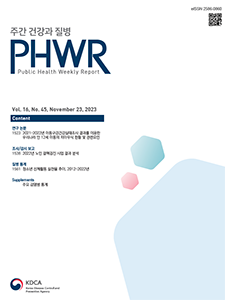Current Issue
Vol.16 No.45, November 23, 2023
-
Original Articles 2023-11-23
 1
1
 326
326
 115
115
Current Status and Associated Factors of Dental Caries in 12-year-old Children in Republic of Korea: Using the 2021–2022 Korea National Children’s Oral Health Survey
Hae-Eun Shin, Sun-Ja Kim, Kyungwon Oh
Public Health Weekly Report 2023; 16(45): 1523-1537 https://doi.org/10.56786/PHWR.2023.16.45.1AbstractThis study aimed to examine the current status of dental caries in the permanent teeth of 12-year-old children in Republic of Korea (the proportion of children with an experience of dental caries and the prevalence) and determine the factors affecting dental caries, by utilizing the 2021–2022 Children’s Oral Health Survey data. The first-year students of 423 middle schools nationwide participated in the survey, and of those, the data from 10,031 boys and 8,640 girls (a total of 18,671 students) were analyzed in this study. A complex samples cross-tab analysis was performed to compare the dental caries experience and prevalence according to the subject characteristics, and a complex samples logistic regression analysis was performed to identify the factors affecting dental caries. The analyses conducted on the 2021–2022 Children’s Oral Health Survey data showed that the proportion of children with dental caries experience was 58.4% and the prevalence was 6.9%. Both the proportion of dental caries experience and its prevalence were higher in girls than in boys. Additionally, the level of the prevalence was associated with geography, subjective income level, history of dental caries preventive care, consumption of soft drinks inducing tooth decay, and subjective oral health status. Because teeth damaged with dental caries cannot be repaired, prevention is more important than treatment. In childhood and adolescence, it is necessary to perform oral hygiene practices in consideration of the factors inducing dental caries.
-
Surveillance Reports 2023-11-23
 0
0
 362
362
 86
86
Results of the Elderly Tuberculosis Screening Project 2022 in the Republic of Korea
Suhwan You, Ahyoung Park, Heeae Kim, Hyegyeong In, Hoyong Choi, Weonjung Joe, Seungho Choi, Hyunyoung Choi
Public Health Weekly Report 2023; 16(45): 1538-1560 https://doi.org/10.56786/PHWR.2023.16.45.2 Abstract
AbstractIn 2022, the Korea Disease Control and Prevention Agency (KDCA) implemented a tuberculosis (TB) screening initiative for older adults, aged over 65 years, who have a high incidence and mortality risk related to TB. The screening involved a survey, a chest X-ray test, and a sputum test. A total of 187,981 older adults had chest X-rays. Of these, 21,248 conducted sputum tests. In total, positive mycobacterial TB was detected in 132 older adults (70.2 per 100,000). This is approximately 2.2 times higher than the incidence of new TB patients (32.2 per 100,000) in 2022. General characteristics of priority screening recipients demonstrated that a high TB detection rate was associated with hypodermic and TB symptoms. General characteristics of second-priority screening recipients demonstrated a high TB detection rate in males, smokers, those with TB symptoms, and those with TB history. Furthermore, even when a chest X-ray indicated inactive TB, a TB confirmation test was conducted. From these, 91 of the 132 older adults with TB, 68.9% were confirmed to have inactive pulmonary TB. The KDCA established the Third Comprehensive Plan for Tuberculosis Management (2023–2027) to promote TB screening for high-risk groups, such as the elderly, to reduce the incidence and mortality risk from TB among the elderly.
-
QuickStats 2023-11-23
 2
2
 171
171
 88
88
Trends in the Proportion of Adolescents Engaged in Physical Activities, 2012–2022
Public Health Weekly Report 2023; 16(45): 1561-1562 https://doi.org/10.56786/PHWR.2023.16.45.3

pp. 1~2097
Most Keyword
?
What is Most Keyword?
- It is the most frequently used keyword in articles in this journal for the past two years.
Most Read
-
Waterborne and Foodborne Disease Outbreaks in the Republic of Korea, 2023
Myung-Jae Hwang, So Yeon Park, Hyungjun Kim, Se Jeong Yang, Sungchan Yang, Jin Seon Yang
Public Health Weekly Report 2025;18: 17-32 https://doi.org/10.56786/PHWR.2025.18.1.2 -
Implementation Plan for the Coronavirus Disease 2019 Vaccination for the 2024–2025 Season: Recommendations of the 6th Expert Committee on Immunization Practices
Hyewook Hwang, Wookeon Lee, Seohyeon Ahn, Young-Sook Choi, Seunghyun Lewis Kwon, Dongwoo Lee, Eun Hwa Choi, SokGoo Lee
Public Health Weekly Report 2025;18: 90-102 https://doi.org/10.56786/PHWR.2025.18.2.3
Editorial Office
+82-43-719-7569





 Full Text
Full Text Cite
Cite


